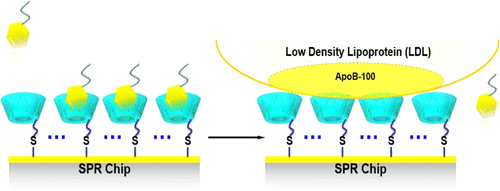Our official English website, www.x-mol.net, welcomes your
feedback! (Note: you will need to create a separate account there.)
Selective and Regenerable Surface Based on β-Cyclodextrin for Low-Density Lipoprotein Adsorption
Langmuir ( IF 3.7 ) Pub Date : 2018-06-20 00:00:00 , DOI: 10.1021/acs.langmuir.8b00883 Fei Fang 1 , Xiao-Jun Huang 1 , Yi-Zong Guo 1 , Xiao Hong 1 , Hui-Min Wu 1 , Rong Liu 2 , Da-Jing Chen 3
Langmuir ( IF 3.7 ) Pub Date : 2018-06-20 00:00:00 , DOI: 10.1021/acs.langmuir.8b00883 Fei Fang 1 , Xiao-Jun Huang 1 , Yi-Zong Guo 1 , Xiao Hong 1 , Hui-Min Wu 1 , Rong Liu 2 , Da-Jing Chen 3
Affiliation

|
Cyclodextrins (CDs) are a family of cyclic oligosaccharides, whose unique hydrophilic outer surface and lipophilic central cavity facilitate the formation of inclusion complexes with various biomolecules, such as cholesterol and phospholipids, via multi-interactions. Low-density lipoprotein (LDL) is the main carrier of cholesterol in bloodstream and is associated with the progression of atherosclerosis. The surface of LDL is composed of a shell of phospholipids monolayer containing most of the free unesterified cholesterol as well as the single copy of apolipoprotein B-100. To date, various LDL adsorbents have been fabricated to interact with the biomolecules on LDL surface. Owing to its elegant structure, CD is considered to be a promising choice for preparation of more economical and effective LDL-adsorbing materials. Therefore, in this study, interaction between β-CD and LDL in solution was investigated by dynamic light scattering, circular dichroism, and ultraviolet spectroscopy. Further, a supramolecular surface based on β-CD was simply prepared by self-assembled monolayer on gold surface. The effect of hydrogen bond and the cavity of β-CD on the interaction between β-CD and LDL was particularly explored by surface plasmon resonance (SPR) analysis. The SPR results showed that such β-CD-modified surface exhibited good selectivity and could be largely regenerated by sodium dodecyl sulfate wash. This study may extend the understanding of the interaction between LDL and LDL adsorbent or the design and development of more efficient and lower-cost LDL adsorbents in the future.
中文翻译:

基于β-环糊精的选择性可再生表面对低密度脂蛋白的吸附
环糊精(CDs)是环状寡糖家族,其独特的亲水性外表面和亲脂性中心腔通过多重相互作用,促进了与各种生物分子(例如胆固醇和磷脂)的包合物的形成。低密度脂蛋白(LDL)是血液中胆固醇的主要载体,与动脉粥样硬化的进展有关。LDL的表面由含有大部分游离未酯化胆固醇以及单拷贝载脂蛋白B-100的磷脂单层壳组成。迄今为止,已经制造了各种LDL吸附剂以与LDL表面上的生物分子相互作用。由于其优雅的结构,CD被认为是制备更经济和有效的LDL吸附材料的有前途的选择。因此,在这项研究中 通过动态光散射,圆二色性和紫外光谱研究了溶液中β-CD和LDL之间的相互作用。此外,通过在金表面上自组装单分子层,可以简单地制备基于β-CD的超分子表面。通过表面等离振子共振(SPR)分析,特别探索了氢键和β-CD腔对β-CD与LDL相互作用的影响。SPR结果表明,这种β-CD修饰的表面表现出良好的选择性,并且可以通过十二烷基硫酸钠洗涤而大量再生。这项研究可能会扩展对LDL和LDL吸附剂之间相互作用的理解,或者在将来设计和开发更有效,成本更低的LDL吸附剂。和紫外光谱。此外,通过在金表面上自组装单分子层,可以简单地制备基于β-CD的超分子表面。通过表面等离振子共振(SPR)分析,特别探索了氢键和β-CD腔对β-CD与LDL相互作用的影响。SPR结果表明,这种β-CD修饰的表面表现出良好的选择性,并且可以通过十二烷基硫酸钠洗涤而大量再生。这项研究可能会扩展对LDL和LDL吸附剂之间相互作用的理解,或者在将来设计和开发更有效,成本更低的LDL吸附剂。和紫外光谱。此外,通过在金表面上自组装单分子层,可以简单地制备基于β-CD的超分子表面。通过表面等离振子共振(SPR)分析,特别探索了氢键和β-CD腔对β-CD与LDL相互作用的影响。SPR结果表明,这种β-CD修饰的表面表现出良好的选择性,并且可以通过十二烷基硫酸钠洗涤而大量再生。这项研究可能会扩展对LDL和LDL吸附剂之间相互作用的理解,或者在将来设计和开发更有效,成本更低的LDL吸附剂。通过表面等离振子共振(SPR)分析,特别探索了氢键和β-CD腔对β-CD与LDL相互作用的影响。SPR结果表明,这种β-CD修饰的表面表现出良好的选择性,并且可以通过十二烷基硫酸钠洗涤而大量再生。这项研究可能会扩展对LDL和LDL吸附剂之间相互作用的理解,或者在将来设计和开发更有效,成本更低的LDL吸附剂。通过表面等离振子共振(SPR)分析,特别探索了氢键和β-CD腔对β-CD与LDL相互作用的影响。SPR结果表明,这种β-CD修饰的表面表现出良好的选择性,并且可以通过十二烷基硫酸钠洗涤而大量再生。这项研究可能会扩展对LDL和LDL吸附剂之间相互作用的理解,或者在将来设计和开发更有效,成本更低的LDL吸附剂。
更新日期:2018-06-20
中文翻译:

基于β-环糊精的选择性可再生表面对低密度脂蛋白的吸附
环糊精(CDs)是环状寡糖家族,其独特的亲水性外表面和亲脂性中心腔通过多重相互作用,促进了与各种生物分子(例如胆固醇和磷脂)的包合物的形成。低密度脂蛋白(LDL)是血液中胆固醇的主要载体,与动脉粥样硬化的进展有关。LDL的表面由含有大部分游离未酯化胆固醇以及单拷贝载脂蛋白B-100的磷脂单层壳组成。迄今为止,已经制造了各种LDL吸附剂以与LDL表面上的生物分子相互作用。由于其优雅的结构,CD被认为是制备更经济和有效的LDL吸附材料的有前途的选择。因此,在这项研究中 通过动态光散射,圆二色性和紫外光谱研究了溶液中β-CD和LDL之间的相互作用。此外,通过在金表面上自组装单分子层,可以简单地制备基于β-CD的超分子表面。通过表面等离振子共振(SPR)分析,特别探索了氢键和β-CD腔对β-CD与LDL相互作用的影响。SPR结果表明,这种β-CD修饰的表面表现出良好的选择性,并且可以通过十二烷基硫酸钠洗涤而大量再生。这项研究可能会扩展对LDL和LDL吸附剂之间相互作用的理解,或者在将来设计和开发更有效,成本更低的LDL吸附剂。和紫外光谱。此外,通过在金表面上自组装单分子层,可以简单地制备基于β-CD的超分子表面。通过表面等离振子共振(SPR)分析,特别探索了氢键和β-CD腔对β-CD与LDL相互作用的影响。SPR结果表明,这种β-CD修饰的表面表现出良好的选择性,并且可以通过十二烷基硫酸钠洗涤而大量再生。这项研究可能会扩展对LDL和LDL吸附剂之间相互作用的理解,或者在将来设计和开发更有效,成本更低的LDL吸附剂。和紫外光谱。此外,通过在金表面上自组装单分子层,可以简单地制备基于β-CD的超分子表面。通过表面等离振子共振(SPR)分析,特别探索了氢键和β-CD腔对β-CD与LDL相互作用的影响。SPR结果表明,这种β-CD修饰的表面表现出良好的选择性,并且可以通过十二烷基硫酸钠洗涤而大量再生。这项研究可能会扩展对LDL和LDL吸附剂之间相互作用的理解,或者在将来设计和开发更有效,成本更低的LDL吸附剂。通过表面等离振子共振(SPR)分析,特别探索了氢键和β-CD腔对β-CD与LDL相互作用的影响。SPR结果表明,这种β-CD修饰的表面表现出良好的选择性,并且可以通过十二烷基硫酸钠洗涤而大量再生。这项研究可能会扩展对LDL和LDL吸附剂之间相互作用的理解,或者在将来设计和开发更有效,成本更低的LDL吸附剂。通过表面等离振子共振(SPR)分析,特别探索了氢键和β-CD腔对β-CD与LDL相互作用的影响。SPR结果表明,这种β-CD修饰的表面表现出良好的选择性,并且可以通过十二烷基硫酸钠洗涤而大量再生。这项研究可能会扩展对LDL和LDL吸附剂之间相互作用的理解,或者在将来设计和开发更有效,成本更低的LDL吸附剂。











































 京公网安备 11010802027423号
京公网安备 11010802027423号